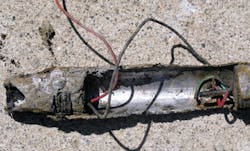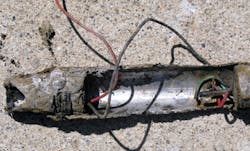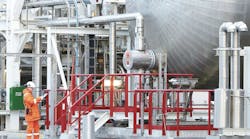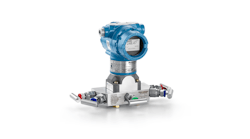An improperly grounded motor electrified the liquid slurry where this submersible pressure transducer was installed, and electrolysis eroded the 316L SS housing. In this scenario, the case ground should not have been connected because the electrical potential of the liquid was higher than the ground at the panel. Photo courtesy of APG (www.apgsensors.com).
In general terms, the most prominent trends in the pressure measurement sector over the past 15 years have been a drive toward smaller and smaller parts, increased accuracy, and improved reliability. And these trends figure to continue in the years to come, as manufacturers leverage advances in microprocessor technology to bring key improvements in the area of pressure measurement.
3 Keys to Better Pressure Measurement
According to Elden Tolman, product development engineer for Automation Products Group, there have been three specific advances that have elevated the pressure measurement process in recent years. First, he says with the development of MicroElectroMechanical Systems (MEMS), the Wheatstone bridge can be etched directly onto a die in one solid piece, thus eliminating errors caused due to gage alignment issues. Having the gages on a single solid piece also allows for simpler assembly and less production scrap.
Second, Tolman says foil gage technology has also seen moderate improvements with respect to pattern design and layout. “[These improvements allow] for self-compensation when torque stresses are imposed on the diaphragm,” he says. “Improvements in both MEMS and foil gage technology have resulted in smaller packages, improved accuracy, and better thermal performance.”
Third, Tolman says microprocessor advances have facilitated more options and greater control in pressure measurement systems. “Signal conditioning, curve fitting, and software control of outputs from pressure transducers/transmitters and digital pressure gauges are just some examples of the possibilities through microprocessor control. In fact,” he says, “it is now possible to get a digital gauge that offers field programmable features such as auto-off, peak hold, auto zero and tare, analog outputs, unit conversion, and data logging all within the palm of the hand.”
The Need for More Accuracy
One key area of improvement in the pressure measurement segment is accuracy, as most modern-day pressure devices are far more precise than previous generations of technology. The drive toward improved pressure measurement accuracy is a product of need, as low-pressure applications that require measurement of less than five PSI are growing more prevalent. Such applications are primarily used in regulatory or lab-type conditions for remote monitoring and controlling of fluid levels in shallow tanks. For example, Tolman cites a customer that uses a five PSI digital pressure gauge with a remote sensor at the end of 20-foot cable to measure the level in underground fuel tanks at gas stations.
Best Practices for Specification & Installation
When specifying a pressure measurement system for a given application, Tolman says the first priority for the end-user should be to consider the environment where the equipment will be used to determine requirements for such key variables as chemical compatibility, vibration, weather-ability, pressure type (absolute, gage, sealed), power availability, communication signal output options, and field calibration. “In the case of pressure gauges, going digital offers superior accuracy and control options, such as field programming and calibration, data logging, etc.,” says Tolman.
Tolman warns users to beware of how specifications are called out and how they are applied. For example, he says some manufacturers will call out a linear accuracy of 0.25 percent of span, which may be calculated using a straight-line method or a best-fit-straight-line (BFSL) method. Some manufacturers will take a single half scale (or midpoint) measurement to do the calculation, which Tolman says can be misleading given that many pressure sensors exhibit a characteristic “S” curve. This means that if they exceed the specification, it will be worst between the zero pressure and half scale or between the half scale and full-scale pressure.
Regarding installation best practices, Tolman says pressure transducers with chassis (or case) ground call for special consideration of grounding techniques. He says, “This becomes increasingly important in applications where there is any chance of a difference in potential between the transducer and the grounding point of the control box.”
Ultimately, improper installation and/or improper use are the primary reasons for poor pressure measurement performance. As such, Tolman says it is always best to follow manufacturer’s recommendations when it comes to specification, installation and maintenance. “Sometimes people who have worked with pressure measurement for years presume they know how things should be done and trust their own experience to be correct even over a manufacturer’s recommendations and warnings,” says Tolman.
Going Forward
Like so many fluid handling-related categories, the pressure measurement segment has benefited from the advent of digital technology. For example, pressure gauges, what at their base level are a simple analog device, are now trending toward high-technology, as Moore’s Law continues to drive down the price and size of high-speed microprocessors that provide added value in certain pressure measurement scenarios. So as we look into the future, we’ll likely see more and more applications turning toward digital pressure measurement with capabilities for software-based control.
Matt Migliore is the editor-in-chief of Flow Control magazine. He can be reached at [email protected].



